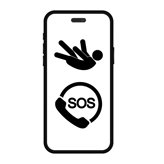Lone worker protection is both a legal obligation and a major safety concern. Yet many organizations make mistakes when setting up their safety systems, which can ultimately endanger the very workers they are meant to protect.
Here are the 8 most common mistakes to avoid to ensure effective lone worker protection.
1.Failing to properly identify lone workers
L'identification des travailleurs isolés
Before selecting any device or solution, employers must clearly identify who can be qualified as a lone worker. Too often, companies only consider night shifts or remote locations. In reality, the risks are much broader:
- A maintenance technician working alone in a factory
- A home-care nurse visiting patients
- A cleaning agent working in an empty building
- A delivery driver on the road at night

Mapping lone-working situations involves:
- Identifying all roles that involve isolation
- Analyzing the working environment
- Assessing specific risks
- Prioritizing risk levels

This approach must be incorporated into the Health and Safety Risk Assessment, which forms the regulatory foundation for occupational risk prevention in the United Kingdom, in accordance with the Health and Safety at Work etc. Act 1974 and the Management of Health and Safety at Work Regulations 1999.
|
2. Assuming the risk is only physical
The dangers of isolation
When people think of lone worker safety, they often focus on physical risks only: falls, medical emergencies, or injuries caused by tools and machinery. While these are significant, lone workers also face psychological and social risks, such as:
- Verbal aggression toward a security guard
- Stress experienced by a nurse during home visits
- A sense of isolation for a delivery driver working irregular hours
A comprehensive strategy must therefore address psychosocial risks (PSR), which are now at the heart of both legal obligations and corporate social responsibility.
3.Treating regulations as optional
Legal obligations

Under the Health and Safety at Work etc. Act 1974, every employer in the United Kingdom has a legal duty to ensure, so far as is reasonably practicable, the health, safety and welfare of their employees while at work.
This duty extends to lone workers, who may face specific risks due to working without direct supervision. Protecting lone workers is not optional, it is both a legal and moral obligation.
Failure to comply with these requirements can expose employers to civil, criminal, and regulatory sanctions, including enforcement notices, fines, and, in serious cases, prosecution.
4. Choosing inadequate devices
Effective protection
Many companies still imagine that lone worker protection requires bulky, impractical equipment. But today, technology provides certified, lightweight, and highly effective solutions.

A modern lone worker protection app can:
- Detect falls automatically
- Trigger SOS alerts
- Stay functional even in areas with weak coverage
These tools combine efficiency, ease of use, and compliance, making them the preferred choice for many organizations.
5. Failing to train employees on device usage
Train to take action

Even the best lone worker device or app is useless if employees don’t know how to use it. Too often, companies distribute devices without proper guidance.
As a result, workers may be unable to trigger an alert in an emergency, putting both themselves and the employer at risk.
Training is essential: it not only ensures the device is used correctly, but also builds employee confidence, knowing they can rely on quick and effective assistance if needed.
6. Neglecting device maintenance
Equipment inspection

A protection system is useless if it is not operational at the moment it is needed. Too often, companies deploy lone worker devices or lone worker protection applications but neglect to ensure that they are functioning properly.
The result: an uncharged device, a faulty SOS button, or an outdated application makes the protection completely ineffective. For example, consider a cleaning operator who suffers a medical emergency at night in a warehouse: if their device is not working, no one will be alerted in time.
It is essential to integrate preventive maintenance and regular testing into the safety procedure.
7. Neglecting emergency preparedness
Intervention in case of problems
Triggering an alarm only makes sense if there is a responsive and effective organization to act on it. An assistance and emergency response plan must address three simple questions:

- Who receives the alert?
- How is it handled?
- What intervention resources are available?
Lone worker protection does not rely only on technology.
To be truly effective, it must be supported by a clear and structured organization: written and shared procedures, teams trained to adopt the right reflexes, regular drills, as well as accurate monitoring of alerts and response times.
It is this combination of prevention, training, and traceability that ensures optimal safety and long-term compliance.
8. Believing a regular phone is enough
A certified mobile device for guaranteed safety

A standard mobile phone does not ensure the safety of a lone worker. This tool is limited, as it assumes that the employee is conscious, able to make a call, and has their phone in hand at the time of the incident.
In many situations, however, this is not the case. That is why it is essential to equip lone workers with certified lone worker protection/lone worker devices. Unlike a simple phone, these solutions can automatically send alerts, even if the employee is unable to act.
✅ Conclusion: how to effectively protect your lone workers
Implementing a comprehensive lone worker protection strategy goes beyond simply providing a device or an application. It involves a combination of several key factors:
- Accurate identification of lone workers,
- Appropriate and certified lone worker devices,
- Employee training,
- Regular maintenance,
- And, most importantly, a clear emergency response organization.
By avoiding the mistakes highlighted in this article, you not only ensure the safety of your employees but also maintain regulatory compliance and peace of mind for your organization.
With Beepiz, you have a simple, high-performance, and connected lone worker protection solution that adapts to any work environment.
